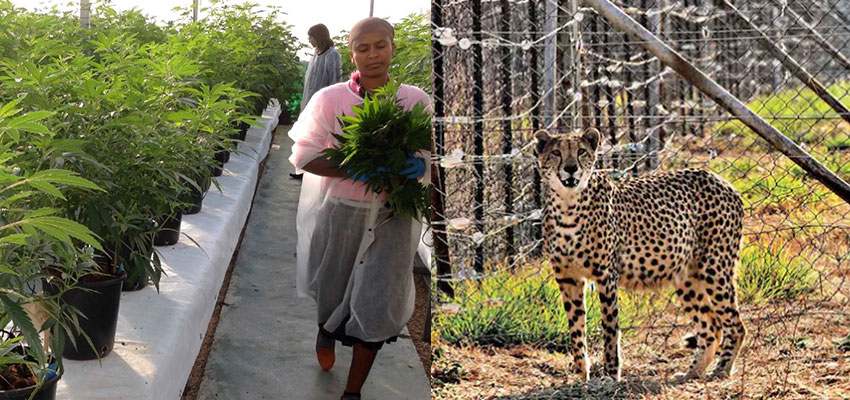
Corporate Citizen claps for India’s first Cannabis Medicine Project initiated by the Council of Scientific & Industrial Research and the Indian Institute of Integrative Medicine, Jammu (CSIR-IIIM, Jammu).
The objective is to tap the medicinal potential of Cannabis and usher its legal cultivation in India. The project, established under Public-Private Partnership (PPP) with a Canadian firm would harness remedies for patients suffering from cancer, neuropathies, epilepsy, and other critical health conditions. The government hopes to kill the stereotype associated with Cannabis, by promoting its therapeutic benefits, while addressing drug abuse challenges across Jammu & Kashmir and Punjab. The CSIR-IIIM and IndusScan venture is expected to unravel research into the potential of developing medicines, enhancing investment opportunities in a space where Cannabis-led medications have been solely imported from foreign countries. The CSIR-IIIM research envisages cultivating and improving superior cannabis culture with new varieties for the desired cannabinoid content for medicinal use, and seek exports too. It would aid pre-clinical regulatory studies for cancer pain and epilepsy management. Manufacturing would be as per the mandatory GMP (good manufacturing practices) norms, for pre-clinical and clinical studies, especially for the discovery of newer therapeutic drugs. Authorities have applied for a license from the Excise Department of the J&K government for GMP manufacturing and exclusive transportation of cannabis material for scientific purposes. Although a progressive thought, state governments will have to keep checks on cannabis cultivation based on the Narcotic Drugs and Psychotropic Substances Act, 1985(1), which prohibits the sale and production of cannabis resin and flowers. However, the use of leaves and seeds of the cannabis plant is permitted. The catch is now to see if legal licensing for medicinal use can be contained without opening up the evils of the ‘weed’ for those who are not scientifically predisposed.
Corporate Citizen slaps the lack of clarity surrounding the death of nine cheetahs, among the 20 that were imported from Namibia and South Africa last year with much fanfare.
Initially, eight Namibian cheetahs were introduced into Madhya Pradesh’s Kuno National Park Reserve, and five months later, 12 more were added from South Africa. The greater concept was to expand India’s ecosystem and find homes for other sub-species, a noble thought perhaps. However, it has cost the lives of the nine cheetahs, without any clear reasons as to what ailed them. Did misplaced initiatives or a lack of scientific introspection lead to these deaths? To save face, experts and officials have been listing varied reasons for the cheetah deaths. Rajesh Gopal, Secretary General of the Global Tiger Forum, conceded that plastic radio collars may have caused the latest deaths in Kuno. Experts wonder if the government would undertake the herculean task of capturing the free-ranging cats, removing their collars, and replacing them with lighter versions! The National Tiger Conservation Authority insisted that the mortalities were due to episodes of heart attack or kidney failure. The lack of natural prey, high temperature, and rugged terrains, further adds to Kuno’s unsuitability for sustaining cheetahs. India’s environment ministry insisted the cheetahs died of natural causes, and sacked a senior Kuno park warden after he blamed collars for the deaths. The agony extended further as three of the four cubs born to a cheetah in the 749 square kilometer Kuno Park did not survive. Valmik Thapar, eminent Indian naturalist, conservationist, and writer, who has watched wild cheetahs across Africa for 25 years, provides historical references from 1725 to 1960, saying thousands of cheetahs were imported from Africa and the rich and famous kept them as pets. He reveals that there has been no wild cheetah population in India and that they were tamed and brought to India and trained for hunting. India’s forest encompasses rocky surfaces and endless gushing streams, including enemy species like the lion, leopards, wolves, hyenas and tigers, making it an uneasy space for the cheetahs. They need to flee, which demands wide, open spaces to pick up speed and escape the enemy. Unfortunately, India has no such open spaces that allow flight mode in the wild for the fastest mammal in the world; fortunately, Africa does, aiding their survival. Thapar said, “The only way out now is to immediately convert this into a captive cheetah project. Enclose a large area and take care of the remaining individuals. Let tourists drive through the area. To even imagine having free-range African cheetahs in India is a deadly idea. It will kill them.”